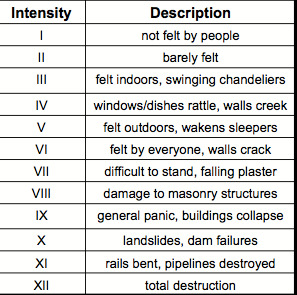V. Outdoor felting; direction may be approximated. Sleeping individuals reawaken. Liquids are agitated, and some are spilled. Objects of a small size are moved or unsettled. Swinging doors open and shut. Pendulum clocks pause, restart, and adjust their pace. VI. Perceived by everybody; many are terrified and flee outside. Individuals walk unsteadily. Photographs tumble off walls. Furniture shifts or topples. Cracks in the plaster and stonework. Tiny bells toll (church, school). Trees and shrubs tremble.
Fear in general - alarm progresses to panic. Disturbed individuals using motor vehicles. Palms that have been violently shook - limbs, trunks, and broken branches, particularly palm trees. Sand and sludge were ejected in trace volumes. Changes: temporary and permanent; in the flow of springs and wells; in the flow of dry wells that have been re-opened; in the temperature of spring and well waters. Slight damage to constructions (brick) constructed specifically to resist earthquakes. Considerable damage to typical large buildings, partial collapse: racked, tumbled down, and in some instances destroyed timber homes; ripped out panel walls in frame structures and severed deteriorated piling. Walls crumble. Significantly cracked, broken, and solid stone walls. To some degree, wet terrain, as well as land on steep slopes. Chimneys, columns, monuments, as well as manufacturing stacks and towers, twist and collapse. Prominently moved, toppled, very hefty furniture. IX. MM.
Although several intensity measures have been established over the past few hundred years to quantify the consequences of earthquakes, the Modified Mercalli Intensity (MMI) Scale is now utilized in the United States. The American seismologists Harry Wood and Frank Neumann invented it in 1931. Roman numerals are used to denote this scale, which is comprised of rising degrees of severity ranging from unnoticeable shaking to devastating damage. It lacks a mathematical foundation; rather, it is a subjective assessment based on observable results. For many individuals, the Modified Mercalli Intensity number given to a particular location after an earthquake is a more relevant indicator of severity than magnitude, since intensity pertains to the consequences actually felt at that location. The lower values on the intensity scale often refer to how an earthquake is perceived by humans. The scale's higher values reflect structural damage that has been seen. Typically, structural engineers provide information for assigning intensity ratings of VIII or above.
To learn more about this intriguing subject, be sure to watch IRIS Earthquake Science's great film, Moment Magnitude. Explained: What Ever Became of the Richter Scale? To summarize, the strength of an earthquake is proportional to its moment magnitude, which is determined by three physical parameters: stiffness, area, and slip.











